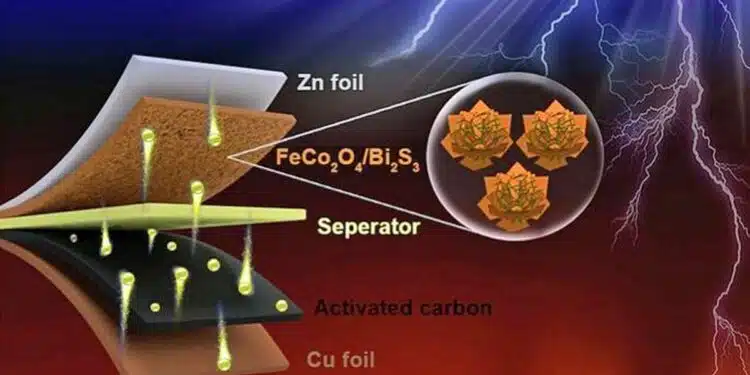Researchers from Iran published article titled: FeCo2O4@Bi2S3 S-scheme heterojunction for photo-rechargeable Zn-ion capacitors in the Chemical Engineering Journal.
Abstract
Solar energy harvesting and storage systems are being developed to address current energy challenges. In this study, we propose novel FeCo2O4 nanoflowers/Bi2S3 nanorods (FCO-NF/BS-NR) heterostructures as photoelectrodes for energy-efficient composite photo-rechargeable zinc-ion supercapacitors (PR-ZICs).
This work evaluates the performance of zinc ion photo-capacitors with FCO/BS composites at varying weight percentages of BS. The optimal photoelectrode (FCO/BS-0.1) exhibited a specific capacitance of 123.25 mF cm−2 under light illumination. The PR-ZIC with FCO/BS-0.1 exhibited superior performance under light, with a specific capacitance of 744 mF cm−2, energy density of 413.33 mWh cm−2, and power density of 882.67 mW cm−2, compared to dark conditions. Additionally, it retained 97.59 % of its capacitance after 10,000 cycles. Thus, the FCO/BS-0.1 photo-enhanced zinc-ion capacitor’s capacitance offers a practical and effective approach to developing a low-cost, highly efficient photo-supercapacitor system.
Keywords: Bi2S3 nanorods; FeCo2O4 nanoflowers; Photoelectrode; Energy storage; Photo-rechargeable; Zn-ion capacitors
Introduction
The global push toward sustainable energy has intensified efforts to develop integrated systems that both harvest and store solar energy efficiently. Photo-rechargeable (PR) energy storage devices, which combine light absorption and electrochemical storage into a single unit, promise to overcome the intermittent nature of solar power. This study introduces a novel S-scheme heterojunction composed of FeCo₂O₄ nanoflowers and Bi₂S₃ nanorods (FCO-NF/BS-NR) as a photoelectrode for zinc-ion capacitors (PR-ZICs), aiming to enhance photocarrier separation and achieve high-performance, long-life photo-supercapacitors.
Key Points
- FeCo₂O₄/Bi₂S₃ S-scheme heterojunctions synthesized for the first time
- Photocarrier recombination effectively suppressed, confirmed by photoelectrochemical analysis
- Photo-rechargeable zinc-ion capacitor (PR-ZIC) successfully constructed using FCO/BS composite
- Exceptional cycling stability: 97.59% capacitance retention over 10,000 cycles
- Specific capacitance boosted to 744 mF cm⁻² under light irradiation
Extended Summary
The FCO-NF/BS-NR heterostructures were fabricated via a single-step hydrothermal process followed by annealing. Initially, hierarchical BS nanorods form when bismuth nitrate and thiourea undergo hydrolysis, creating a porous, lamellar Bi₂S₃ framework. FeCo₂O₄ nanoflowers then grow atop these rods, establishing intimate interfacial contact. Structural and morphological analyses confirmed the formation of the S-scheme heterojunction, which is critical for directional charge transfer and reduced recombination.
Photoelectrochemical measurements revealed that the FCO/BS-0.1 composition—where BS accounts for 10 wt% of the composite—achieved the highest photocurrent density among tested ratios. Under visible light, this electrode delivered a specific capacitance of 123.25 mF cm⁻², more than double its dark performance. These results demonstrate the heterojunction’s ability to harness solar photons and convert them into stored charge with minimal losses.
The PR-ZIC device was assembled using symmetric electrodes of FCO/BS-0.1 on zinc foil. Under illumination, the capacitor’s performance surged to a specific capacitance of 744 mF cm⁻², an energy density of 413.33 mWh cm⁻², and a power density of 882.67 mW cm⁻². Compared to dark conditions, these metrics represent a dramatic enhancement in both energy and power handling, showcasing the practical viability of the photo-enhanced system for on-demand energy delivery.
Long-term cycling tests under light exposure demonstrated outstanding stability: the PR-ZIC retained 97.59% of its initial capacitance after 10,000 cycles. This robustness arises from the S-scheme heterojunction, which not only accelerates charge separation but also mitigates structural degradation by uniformly distributing redox reactions across the electrode surface.
Mechanistically, the FCO/BS heterojunction leverages band alignment between FeCo₂O₄ and Bi₂S₃ to drive photogenerated electrons toward the conduction band of FeCo₂O₄ while holes migrate into Bi₂S₃. This S-scheme charge-transfer pathway reduces electron–hole recombination and maximizes light utilization. Additionally, the high surface area and abundant active sites of the nanoflower–nanorod architecture facilitate rapid ion diffusion and electron transport, further boosting capacitive performance.
Conclusion
This work pioneers the integration of FeCo₂O₄ nanoflowers and Bi₂S₃ nanorods into an S-scheme heterojunction for photo-rechargeable zinc-ion capacitors. The optimized FCO/BS-0.1 electrode exhibits superior photoelectrochemical properties, translating into a PR-ZIC with high specific capacitance, exceptional energy and power densities, and remarkable cycling stability. By employing earth-abundant, low-cost materials and a scalable synthesis route, this study lays the groundwork for developing practical, efficient, and durable photo-supercapacitors that could power the next generation of portable electronics and off-grid energy systems.
Read the full scientific article:
Sara Ramandi, Mohammad H. Entezari,
FeCo2O4@Bi2S3 S-scheme heterojunction for photo-rechargeable Zn-ion capacitors,
Chemical Engineering Journal,
Volume 520,
2025,
166373,
ISSN 1385-8947,
https://doi.org/10.1016/j.cej.2025.166373.
(https://www.sciencedirect.com/science/article/pii/S1385894725072110)































